2009 UN
2009 CTAUN Conference
Friday, 30 January 2009
Protecting Human Rights The United Nations —Our Schools
Welcome and Opening Address
Anne-Marie Carlson
Conference Chair.
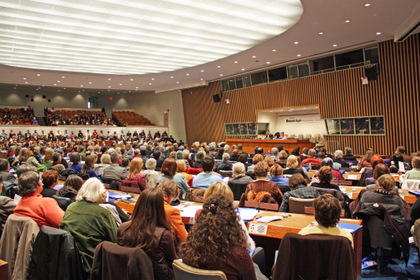 In her opening remarks, Anne-Marie Carlson, Conference Chair and Chair of CTAUN, commented that the day’s program would be focusing on human rights in honor of the 60th anniversary of the signing of the Universal Declaration of Human Rights, which had just occurred during the previous December. She said that during the morning session participants would be looking at some current challenges and opportunities relating to human rights and how the United Nations protects the rights of so many, and that the afternoon’s focus would be on human rights and education. Ms. Carlson then went on to announce that 801 people had registered for this conference, which was a record number for the CTAUN conferences. Among those in attendance were educators from all over the world, including 68 Fulbright teachers and scholars from 35 countries.
In her opening remarks, Anne-Marie Carlson, Conference Chair and Chair of CTAUN, commented that the day’s program would be focusing on human rights in honor of the 60th anniversary of the signing of the Universal Declaration of Human Rights, which had just occurred during the previous December. She said that during the morning session participants would be looking at some current challenges and opportunities relating to human rights and how the United Nations protects the rights of so many, and that the afternoon’s focus would be on human rights and education. Ms. Carlson then went on to announce that 801 people had registered for this conference, which was a record number for the CTAUN conferences. Among those in attendance were educators from all over the world, including 68 Fulbright teachers and scholars from 35 countries.
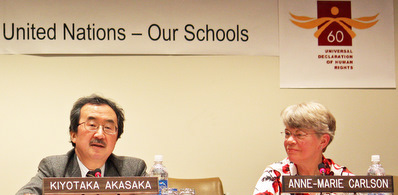
Mrs. Carlson stated that, of the many crises facing children and youth, those singled out for particular attention at this conference were issues related to health and nutrition, literacy, security, and the rights of the child. Attention was drawn to the list of exhibitors at the conference Information Fair.
UN Welcome
Kiyotaka Akasaka
Under-Secretary-General
Extending the welcome to the United Nations was Kiyotaka Akasaka, Under- Secretary-General, Communications and Public Information (UN/DPI)
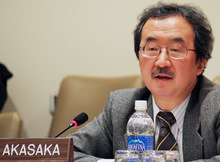 Mr. Akasaka opened his remarks by thanking all present at the Conference who work as educators to spread the word about the United Nations and all its initiatives to the young people who represent the hope and future of the world. He stated that he was conveying greetings from Secretary-General Ban Ki-moon, who was currently in Davos, Switzerland. He then read to the conference the message from Secretary-General Ban.
Mr. Akasaka opened his remarks by thanking all present at the Conference who work as educators to spread the word about the United Nations and all its initiatives to the young people who represent the hope and future of the world. He stated that he was conveying greetings from Secretary-General Ban Ki-moon, who was currently in Davos, Switzerland. He then read to the conference the message from Secretary-General Ban.
In his remarks, Mr. Akasaka continued with the theme that education is critical if people are to reach their potential. We need to promote education and, internationally, ask ourselves how we can raise the level of education in order to overcome pressing global challenges.
The importance of human rights education in particular was emphasized by Mr. Akasaka, and he stressed that we need to raise the awareness of American children that the rest of the world must be educated if we are to effect change. There are no boundaries or borders where education is concerned. He also reminded us of the 60th anniversary of the signing of the Universal Declaration of Human Rights and how very far we have to travel to implement those vital principles. Speaking to those present, he said “As educators you model the concept of global citizenship…where we are accountable not only to those around us but to people throughout the world.”
Mr. Akasaka mentioned materials that promote both education and human rights understanding, including those available on the UN Cyberschoolbus website and here at this conference, as well as the Model UN programs now implemented in hundreds of schools. He also announced a new initiative, the first annual Global Model United Nations Conference, which will have its first meeting this coming August 5-7 in Geneva, Switzerland. The theme is the Millennium Development Goals: Lifting the Bottom Billion out of Poverty. The conference will rotate to other major cities annually. It will initially target university students world-wide between the ages of 18 and 24.
He noted that the 60th anniversary of the Universal Declaration of Human Rights saw the announcement of another major UN initiative addressed to teachers, scholars and students: the Academic Impact, which offers institutions the opportunity to undertake specific actions in support of, and in partnership with, the UN to realize the Declaration’s broad and enduring vision.
Mr. Akasaka illustrated his points regarding the importance of the education of youth with the proverb, “Give me a fish and I will eat. Teach me to fish and I will never go hungry.” Akasaka said that his father was a high school social studies teacher and that he is envious of those opportunities his father had to instill knowledge to youth. Watching what his father did, he learned “how important it is to teach young people to fish….There is nothing more important than education.”
Finally, Mr. Akasaka stated, the situation regarding human rights has not improved as much as expected. Despite our expectations, what has happened over the past ten years has not been encouraging. The importance of education cannot be over-estimated, and all citizens need to work toward implementing and respecting human rights in our daily lives.
Opening Address
The 60th Anniversary of the Universal Declaration of Human Rights: Challenges and Opportunities
Craig Mokhiber
Deputy Director, New York Office of the High Commissioner for Human Rights (www.ohchr.org).
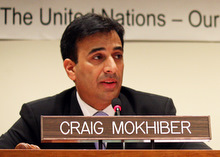 Mr. Mokhiber began his address by stating that human rights is one of the three principal purposes of the United Nations, the organization that gave birth to the Universal Declaration of Human Rights, at a time right at the end of World War II, right after the holocaust, with much of the world still locked in the chains of colonialism and parts of the United States still practicing legal racial segregation. “It was at that moment of darkness that the people of the world—not just the governments—but the people of the world came together to try to provide a light in the middle of that darkness.” It was an initiative led by Eleanor Roosevelt, with active and meaningful input by people all around the world and civil society. The original premise is that “all human beings are born free and equal in dignity and rights by virtue of being born human.”
Mr. Mokhiber began his address by stating that human rights is one of the three principal purposes of the United Nations, the organization that gave birth to the Universal Declaration of Human Rights, at a time right at the end of World War II, right after the holocaust, with much of the world still locked in the chains of colonialism and parts of the United States still practicing legal racial segregation. “It was at that moment of darkness that the people of the world—not just the governments—but the people of the world came together to try to provide a light in the middle of that darkness.” It was an initiative led by Eleanor Roosevelt, with active and meaningful input by people all around the world and civil society. The original premise is that “all human beings are born free and equal in dignity and rights by virtue of being born human.”
There is a corresponding obligation of all governments to provide both freedom from fear (which includes the right to a fair trial, freedom of speech, of press, of lawful assembly, of religion, and freedom from torture) and freedom from want (which includes the right to education, housing, food, and health). The upholding of human rights is the litmus test for the legitimacy of governments, for whether they are doing what they are supposed to do to provide freedom from fear and freedom from want.
Mr. Mokhiber pointed out that the Universal Declaration of Human Rights is the most translated document in the world, according to the Guinness Book of World Records. It has been translated not only by the United Nations, but also by the people themselves. There have been translations into over 360 languages. The Declaration has been followed by the adoption of dozens of human rights treaties in all areas of life. We have treaties regarding immigration, racial discrimination, torture, and the rights of children. One of these, The Convention on the Rights of the Child, has been ratified by every government of the world except two—Somalia and the United States of America. The majority of the countries of the world have ratified these human rights treaties, and the UN has monitors and investigators all around the world to see the degree to which these treaties are being respected—or more often the degree to which they are being violated.
Today we are choosing our words very carefully. We are not talking about a celebration of the sixtieth anniversary but a commemoration and, more importantly, a reaffirmation of the Declaration. Mr. Mokhiber emphasized that we should be very clear about this: we are moving backwards, and the light of human rights is beginning to fade. The very idea of human rights is under assault. The primacy of human rights is being questioned on three fronts. First, security and counter-terrorism is declared to trump rights. Security should be considered that of the individual, not of governments. We need to be free of fear not only of terrorists, but of our own government. We are also told that global markets are supposed to trump human rights. Such things as food, housing, education, and health care are said to be commodities, not rights, and therefore subject to the free market. Third, borders and security walls are asserted over the rights of refugees. People with legitimate claims to asylum are told that they should simply go away because we have borders.
This light of the Universal Declaration is fading. It fades a little more every time someone is tortured, raped, murdered, or discriminated against. We can’t wait for governments, the UN, Amnesty International, or anybody else to defend rights. “This requires the mobilization of all peoples and, let me say here, especially educators. Education is power.” It is the educators’ job to promote values and standards so that everyone knows their rights, demands their rights, and defends their rights, not only for themselves but for all people. We must be sure that not only our own rights are protected but also the rights of the other. “As Martin Luther King said, ‘Injustice anywhere is a threat to justice everywhere.'” The flame of human rights can be rekindled by making people well aware, injecting human rights into education meaningfully, powerfully.
Morning Panel
“The United Nations and Human Rights”
William Pace
Convenor, NGO Coalition for an International Criminal Court, served as panel moderator and speaker (www.iccnow.org).
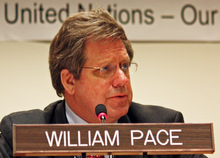 Mr. Pace began his remarks by stating that CTAUN is the kind of organization that is indispensable at the present time in meeting the goals of the UN and that a meeting like this conference is fundamental. He also recognized Barbara Walker as the former chair and Anne-Marie Carlson as the present chair of CTAUN.
Mr. Pace began his remarks by stating that CTAUN is the kind of organization that is indispensable at the present time in meeting the goals of the UN and that a meeting like this conference is fundamental. He also recognized Barbara Walker as the former chair and Anne-Marie Carlson as the present chair of CTAUN.
The United Nations Charter and the Universal Declaration of Human Rights were described by Mr. Pace as tremendous advances by the international community and by citizens’ organizations— basic documents that were great advances in their time. However, it is important to note that, if they were presented today, neither would be approved. It is important to get the international community to the point of acknowledging the tenets of the United Nations stressing dignity, justice, freedom from fear, and freedom from want.
Mr. Pace said that in 2005 a summit met to address the question: “What kind of UN do we want in the 21st century?” There were three important peace tools that emerged from that summit:
- A new peace-building commission, which is a commission in which the General Assembly, the Economic and Social Council and the Security Council will work with the World Bank and the International Monetary Fund to try to integrate better the coordination between peace operations and post-conflict re-building of countries. The international community occasionally works to stop a terrible war or conflict but then does not stay long enough to help shepherd that country, or those peoples, back to a sustainable peace.
- Identification of a new norm, called “the responsibility to protect,” that addresses the failure of the United Nations and of governments, including the United States government, to prevent the various genocides, war crimes, and crimes against humanity.
- The establishment of a Human Rights Council of the General Assembly, which would not only say that human rights is one of the three pillars of the United Nations, but would elevate its stature from being part of the Economic and Social Council to being a council of the General Assembly.
Mr. Pace stated that “We don’t know whether any of these tools will survive the next two or three CTAUN conferences. They are all fragile… But we are desperately trying to make these succeed.”
Mr. Pace said that before closing he wanted to make a comment about education. When he grew up he had an excellent education but did not learn about the United Nations or international affairs. It was all national. He feels that there has been a great change in education regarding international affairs over the last generation.
He said that he also wanted to make a comment regarding the UN budget. Where he grew up, in Wyoming, that state has the second smallest budget in the United States, next to South Dakota. However, “the budget of the governor of the state of Wyoming is twice the budget of Ban Ki-moon at the UN.” The international community is spending next to nothing on international peace. The peace budgets are a fraction of a municipal police force. As much as is being done is being done with extremely limited resources and budgets.
He concluded by saying, “The Preamble begins with the statement that one of the goals of the United Nations is ‘To save future generations from the scourge of war.’ One of the most fundamental ways that the UN can do that is the promotion of human rights.
Carolyn Hannan
Director, United Nations Division for the Advancement of Women (DAW), Department of Economic and Social Affairs (DESA) (www.un.org/womenwatch/daw).
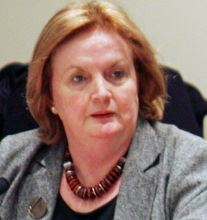 Ms. Hannan opened by stating that she considered it a great honor for her to be speaking at this conference celebrating the 60th anniversary of the adoption of the Universal Declaration of Human Rights on 10 December 1948. She reminded the audience that “The Charter of the United Nations is the first international agreement to reaffirm, in its Preamble, the faith of the peoples of the United Nations ‘in the equal rights of men and women.’ Article 1 sets out, as one of the purposes of the United Nations, the promotion and encouragement of the respect for human rights and fundamental freedoms for all, without distinction on the grounds of ‘race, sex, language, or religion.'”
Ms. Hannan opened by stating that she considered it a great honor for her to be speaking at this conference celebrating the 60th anniversary of the adoption of the Universal Declaration of Human Rights on 10 December 1948. She reminded the audience that “The Charter of the United Nations is the first international agreement to reaffirm, in its Preamble, the faith of the peoples of the United Nations ‘in the equal rights of men and women.’ Article 1 sets out, as one of the purposes of the United Nations, the promotion and encouragement of the respect for human rights and fundamental freedoms for all, without distinction on the grounds of ‘race, sex, language, or religion.'”
She then pointed out that, three years after the founding of the United Nations, the Universal Declaration of Human Rights established the fundamental right of equality and non-discrimination as a corner stone of the international human rights framework. The Declaration’s core principal is that “human rights are based on the ‘inherent dignity’ of every human person, with inalienable rights and freedoms belonging equally to every person ‘without distinction of any kind.'”
Ms. Hannan than provided an overview of the various conferences, conventions and treaties that address or have implications for equal rights for women. More recently particular attention has been given to violence against women, particularly during armed conflict, and to trafficking in women. The Secretary-General of the United Nations recently launched a multi-year campaign (2008-2015) “UNiTE to End Violence Against Women.” He has called upon all stakeholders and actors to work with him in eradicating this significant human rights abuse by 2015. Ms. Hannan added “I would encourage all educators—including teachers, administrators and others represented here—to be part of this important global initiative.”
Ms. Hannan noted that various global issues, such as climate change, the need for water, and deforestation have an effect on human rights, in particular for women and girls, because women in rural areas are primarily responsible for securing water, staple food and energy for cooking and heating, and the effects of these problems makes it harder for them to secure such resources. She closed by stating that there is a need for the UN and governments to work in conjunction with human rights groups. “Education has a critical role in achieving this. The inclusion of comprehensive human rights education in curricula at all levels…is essential for the elimination of discrimination and violence against women and girls and inequalities between women and men. I encourage and commend all of you in your efforts to ensure such an educational system.”
Celia Brown
Board President, MindFreedom International (MFI) (www.mindfreedom.org).
 Ms. Brown explained that she works for rights for people with disabilities and it was in this very room that the International Convention for the Rights of People with Disabilities met. A key provision of the Convention in working for the rights of persons with disabilities is a human rights approach rather than the frequently seen paternalistic approach. Another provision advocates a non-discriminatory approach to giving autonomy and decision-making ability to people with disabilities so that they are implemented without regard to racial background. She spoke of the need to implement the shared responsibility of governments, people with disabilities and NGOs and civil society to work in partnership and be inclusive in implementing the provisions of the International Convention for the Rights of People with Disabilities.
Ms. Brown explained that she works for rights for people with disabilities and it was in this very room that the International Convention for the Rights of People with Disabilities met. A key provision of the Convention in working for the rights of persons with disabilities is a human rights approach rather than the frequently seen paternalistic approach. Another provision advocates a non-discriminatory approach to giving autonomy and decision-making ability to people with disabilities so that they are implemented without regard to racial background. She spoke of the need to implement the shared responsibility of governments, people with disabilities and NGOs and civil society to work in partnership and be inclusive in implementing the provisions of the International Convention for the Rights of People with Disabilities.
Ms. Brown posed the question: How do we ensure inclusive education, which is the right of people with different kinds of disabilities to be educated to their full potential? She urged that educators work in partnership with people with disabilities and disability organizations to develop a curriculum that would permit all children to be educated together and accept and understand each other from an early age. She also stated that every person has the right to work as they freely choose based on the principles of equal opportunity and equal treatment with reasonable accommodations. Persons with disabilities have the same rights to employment and career advancement as others, and it is necessary to facilitate their employment.
In developing countries, there is a need to set up small businesses that will provide employment for persons with disabilities. They require assistance for small businesses to be set up for them. MindFreedom International is currently working on a campaign to set up affiliates in various developing countries. Ms. Brown said that they now have a MindFreedom Ghana that is very active and has received a grant to work with people with psycho-social disabilities in that country. There are grass-roots groups working together.
Ms. Brown continued by saying that people with mental disabilities should be regarded as having the human right to participate in their own treatment. Some people are put away under dreadful conditions in mental health institutions and their human rights are taken away from them. Persons with psychological/social issues have the right to participate in decisions regarding their own treatment. It has been reported that they are often placed under coercion, including torture, to force them into treatment.
In closing, Ms. Brown emphasized her desire to work so that “We really have a society in which we all could work together in partnership, so that people with disabilities are recognized as having human rights and being a part of society.”
Afternoon Panel
(Video Conferencing Event)
Teaching About Human Rights
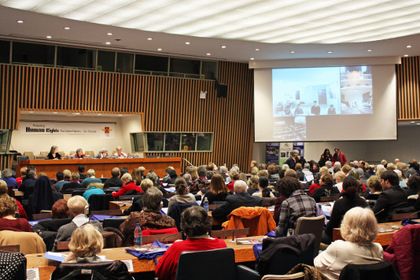 The afternoon panel was presented in a videoconferencing context arranged by Wayne Jacoby, president of Global Education Motivators (GEM) working in close association with the United Nations Department of Public Information. GEM was founded in 1981 as a 501(c)(3) non-profit organization to help schools meet the complex challenges of living in a global society. GEM currently operates as a public foundation headquartered at Chestnut Hill College in Philadelphia, PA (www.gem-ngo.org).
The afternoon panel was presented in a videoconferencing context arranged by Wayne Jacoby, president of Global Education Motivators (GEM) working in close association with the United Nations Department of Public Information. GEM was founded in 1981 as a 501(c)(3) non-profit organization to help schools meet the complex challenges of living in a global society. GEM currently operates as a public foundation headquartered at Chestnut Hill College in Philadelphia, PA (www.gem-ngo.org).
As introduced by Conference Chair Anne-Marie Carlson, representatives from the following three schools in different parts of the world participated in the videoconferencing arrangement:
Burnaby School District, Burnaby, British Columbia, Canada. This school district, which is adjacent to Vancouver, has 40 elementary (K-7) and 8 secondary (8-12) schools that offer programs at all levels in English and French Immersion. All schools serve a number of English as a Second Language students, as well as a growing number of refugees from around the world. The teacher participants for the afternoon panel at the UN represented the district as a whole. The school’s principal, who identified himself as Peter, said that the school “sees a social responsibility to make a difference in the global community” and that they were exploring “How do we do that?”
Lycée Bilingue d’Application, Yaounde, Cameroon. Yaounde, the capital of Cameroon, has a population of over 1.4 million. This school, which is located behind the Government Higher Education Teacher Training College, serves as a placement school for student teachers. The videoconferencing participants were 16 and 17 year old Francophone students in Form 5. They are all studying English as a Second Language. Martha Beck, Educational Consultant, was the leader and organizer of this group.
Karachi High School, Karachi, Pakistan. This is a private co-education institute, founded in 1985, with approximately 650 students ranging from kindergarten through the secondary school level. The school offers a wide variety of subjects, and children are made familiar with computers from the age of five. The students are also offered a wide range of extra-curricular activities, and KHS is the only school that represents Pakistan in the International Little League Baseball Tournaments.
Participants from each of the schools were presented in a televised segment on a large screen overlooking the conference room. The session began with greetings from members of each of the schools and brief remarks back and forth between the schools and the CTAUN Conference stage. This was followed by the introduction of the afternoon panel moderator and speakers.
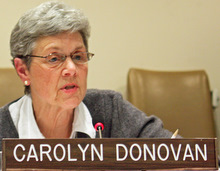
Carolyn Donovan
Second Vice-Chair, CTAUN, and panel moderator.
Charlotte Cole
Vice President of Education and Research at Sesame Workshop (www.panwapa.com).
 Charlotte Cole came to the CTAUN conference from Sesame Street, “the longest street in the world,” where “Muppet diplomacy” stretches through Bangladesh, China, Egypt and India… to name a few of the countries at the beginning of the alphabet.
Charlotte Cole came to the CTAUN conference from Sesame Street, “the longest street in the world,” where “Muppet diplomacy” stretches through Bangladesh, China, Egypt and India… to name a few of the countries at the beginning of the alphabet.
Ms. Cole traced the history of Sesame Street, beginning with its roots in the 1960s, a time of “turbulence and change” in this country. In 1966 a television producer, Joan Ganz Cooney, put forward what was at the time a revolutionary idea, that television could be used to help children prepare for school. The basis of Sesame Street was that young children, rather than just learning advertising jingles on television, could be learning information of value, such as the alphabet and counting. Now, forty years later, Sesame Street reaches children of every demographic group, and numerous studies demonstrate its educational effectiveness.
Ms. Cole stated that “We call each season of Sesame Street ‘experimental’, because we are constantly evolving to meet the needs of children.” Every year the most pressing issues are integrated into a new curriculum framework for the materials that are developed across all areas—cognitive, emotional, social and physical. “For example, we have now started a ‘healthy habits’ initiative.… Cookie Monster now eats cookies as a ‘sometime’ food,” and there is also a growing environmental awareness.
Early on, broadcasters from other countries approached the Workshop, but they wanted their own version of Sesame Street, not a dubbed American program, that would meet the needs in their own countries. What evolved was a model that uses the Sesame Street framework, but with programs developed by educators in the individual countries. Many of these programs are directly linked to human rights issues, but in ways that are culturally sensitive and that reflect the developmental needs of young children. Many of the projects directly parallel the Millennium Development Goals—particularly achieving universal primary education, promoting gender equity, and combating HIV/AIDS, malaria, and other diseases. Many of the projects include training components for parents, caregivers and teachers, to support them in providing high-quality education.
For example, in the Bangladesh program that was started in 2005, which emphasized basic literacy, math, and other cognitive skills, there is also an emphasis on Bangladeshi culture. There are both Bangli-speaking Muppets and puppets designed by a local puppeteer representing Bangladeshi characters. Longitudinal studies have shown a strong positive impact on the children who view the program.
Gender equity is a strong component of many of the programs. The attempt is made to encourage girls, but perhaps more importantly encourage their brothers, to believe that girls can aspire to be anything they want to be. Sesame Street provides children with positive images; it gives them a “portal” into their own and other worlds, helping to combat the negativity around them.
Shulamith Koenig
Founding President of the People’s Movement for Human Rights Learning, formerly known as the People’s Decade for Human Rights Education (www.pdhre.org).
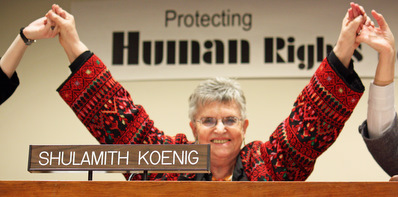
Ms. Koenig began her address, as she said she always does, by asking the audience to join hands in a shout-out: a hands-up “power to human rights.”
She regards human rights learning as similar to learning traffic regulations: you would teach a child to drive, not just give out the keys. The shortest version of human rights rules involves classroom and home skills. As a classroom activity, Ms. Koenig stated that there is a short children’s version of the Universal Declaration of Human Rights. She suggested that teachers have students take one line each and read it aloud, and stressed the importance of “the final one—that no one’s human rights can violate another’s.”
She also suggested that teachers ask the following questions—representing the polar ideas of humiliation and dignity:
When was the first time your human rights were violated?
When was the first time your human rights were affirmed?
She then added, “Tell your children from your own experience.”
The International Year of Human Rights Learning requires psychological, educational, social and team work, as well as behaving as Gandhi and talking to the last person on earth. It involves understanding from one’s own experience that all human rights are in this framework. She added that “Within two sentences a woman’s life is often described: married at 13 and educated at 52,” and that we need to move away from that. Ms. Koenig stressed that it is most important that we help people move away from the idea that being afforded their human rights is a matter of charity rather than due their dignity as human beings.
Ms Koenig believes that “all education is human rights…. There is “no option but human rights.” She prefers, however, to talk about “human rightslearning, rather than “human rights education,” in order to emphasize the dignity of the person, with the emphasis on “the person as the learner” in educational situations.
During the videoconferencing question period that followed, a participant from Karachi High School stated that they are teaching a more globalized curriculum, they have an equal number of boys and girls, and are trying to move toward gender equity. He then asked: “How do you deal with apathy among young people?” Ms. Koenig’s response was that “apathy is a kind of protectionism”. The apathetic see themselves as the center of the world; they need to know its opposite—identity—which sees humanity as the world’s center.” She continued, however, with the comment that “apathy, for women, is often a form of survival in a patriarchal society.”
Ms. Koenig was also asked: “Which of the human rights should be addressed in the classroom?” Her response was that children need to learn about how other children live. “The more each learns about the other—that’s human rights. Respect and understanding, promoting our common humanity—these are the basic issues.”
Keynote Speaker:
Greg Mortenson
Greg Mortensen is Co-founder of the nonprofit Central Asia Institute(www.ikat.org)and Pennies for Peace (www.penniesforpeace.org), and co-author of Three Cups of Tea—One Man’s Mission to Promote Peace…One School at a Time (www.threecupsoftea.com).
 Joining Mr. Mortenson on the platform was Christiane Leitinger, the Pennies for Peace Program Director, along with her daughter, Isabel. In her introductory remarks, Conference Chair Anne-Marie Carlson remarked that many of those present had probably seen Greg Mortenson and his daughter, Amira, on the NBC Today Show of 22 January 2009, and learned then, as she had, that he had been nominated for the Nobel Peace Prize by a bi-partisan group of six members of Congress. The nomination stated in part: “He has overcome great adversity, escaping brutality and death, to continue his commitment to providing educational opportunities to children, especially girls, living in Pakistan and Afghanistan. As we well know, educating females in these countries remains controversial. Mr. Mortenson understands the positive, peaceful impacts that educated girls and women have on societies around the world. He advocates girls’ education as the key to economic development and peace.”
Joining Mr. Mortenson on the platform was Christiane Leitinger, the Pennies for Peace Program Director, along with her daughter, Isabel. In her introductory remarks, Conference Chair Anne-Marie Carlson remarked that many of those present had probably seen Greg Mortenson and his daughter, Amira, on the NBC Today Show of 22 January 2009, and learned then, as she had, that he had been nominated for the Nobel Peace Prize by a bi-partisan group of six members of Congress. The nomination stated in part: “He has overcome great adversity, escaping brutality and death, to continue his commitment to providing educational opportunities to children, especially girls, living in Pakistan and Afghanistan. As we well know, educating females in these countries remains controversial. Mr. Mortenson understands the positive, peaceful impacts that educated girls and women have on societies around the world. He advocates girls’ education as the key to economic development and peace.”
Mr. Mortenson began his remarks by affirming his commitment to education: Education can make a difference. He asked, “How many young persons talk to their grandparents about war or their personal history?” Talking to their elders is part of the tradition of Afghanistan and Pakistan; they know they can learn from their elders. He said that when he asks that question of young people in Pakistan, Afghanistan or Africa, about 90 percent of the hands go up. When he asks it in this country, only about 10 percent of the hands go up. “It is a tragedy that so many children are not in the habit of talking with their elders.”
A DVD newly-produced by Pennies for Peace was shown, in which Mr. Mortenson and Amira were seen walking in a mountain area in Pakistan while she asked her father about how he had started building schools in that country and why he thinks that is so important. Through the DVD and his remarks afterward, he gave a brief overview of the story told in Three Cups of Tea. Mr. Mortenson focused on certain parts of his life story, including his early life in Africa. He said that his father was a doctor who insisted that the department heads of the hospital he ran in Tanzania should be from Tanzania. He learned a similar lesson when the tribal elders of Pakistan told him, when he wanted to build his first school in Pakistan, to let them do the building and “more or less stay out of the way.”
Mr. Mortenson insisted that girls’ education is key: “If we educate a boy, we educate an individual; if we educate a girl, we educate a community.” He pointed to a study that shows that educating girls reduces infant mortality, limits the population explosion and influences health. The ability to communicate is a major plus for women: they learn about the world, how to write letters, and refuse to let their sons join the Taliban. In commenting on affairs in Afghanistan and Pakistan, he stated that the reason we are not having more success in Afghanistan is because the planners are all centralized, whereas Afghanistan is provincialized and decentralized. However, the schools which he has built have hired some former members of Taliban who wanted to teach in them, often in danger of their lives.
He closed by saying that education gives hope, and if one has hope, one can do anything.
When Mr. Mortenson asked his Pakistani mentor, Haji Ali, what he could do in his memory, the answer was “Listen to the wind.” Mortenson strained to listen, and along with the sound of the wind coming down from the mountains he heard the musical trill of children’s voices at play at the Korphe school. He “listened to the wind” and heard the voices of children who had needed a school; he found his “field of dreams” in Pakistan.
Closing Comments
Narin Stassis
First Vice Chair, CTAUN
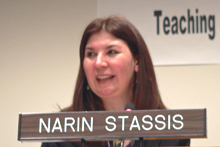 Ms. Stassis thanked Mr. Mortenson for his presentation, and then introduced student representatives from schools in the area who brought donations for Mr. Mortenson of money raised in their schools for Pennies for Peace. Ms. Leitinger said that participating in Pennies for Peace teaches children that even the youngest among them with the smallest amount are able to do something good in the world. Ms. Stassis closed the session by remarking that Mr. Mortenson’s journeys have led him to reach across oceans and mountains to help those in need of education. “As educators sitting here, your accomplishment of bringing your word to deed has motivated so many adults and young people to know that one person can make a difference…. You have accomplished bringing so much inspiration to so many, not by simply writing your book and putting it down, but by involving them and putting that inspired commitment to action.”
Ms. Stassis thanked Mr. Mortenson for his presentation, and then introduced student representatives from schools in the area who brought donations for Mr. Mortenson of money raised in their schools for Pennies for Peace. Ms. Leitinger said that participating in Pennies for Peace teaches children that even the youngest among them with the smallest amount are able to do something good in the world. Ms. Stassis closed the session by remarking that Mr. Mortenson’s journeys have led him to reach across oceans and mountains to help those in need of education. “As educators sitting here, your accomplishment of bringing your word to deed has motivated so many adults and young people to know that one person can make a difference…. You have accomplished bringing so much inspiration to so many, not by simply writing your book and putting it down, but by involving them and putting that inspired commitment to action.”
Other Highlights
CTAUN’s 2008 Best Practices Award was presented by Phyllis Hickey, CTAUN Director-at-Large.
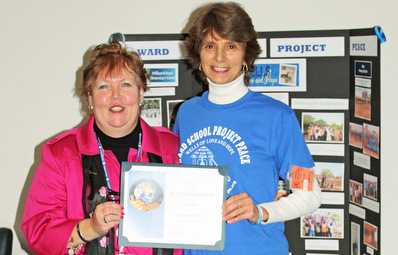
One of the most important aims of CTAUN is to familiarize educators with the work of the United Nations and inspire them to find ways of helping their students learn about its goals and its work in all parts of the world. Every year CTAUN grants an award or awards for reports of “Best Practices” inspired by preceding conferences. There is much variety in the activities that are developed and the depth in which they are reported. The three Best Practices awards presented at the 2009 Conference for projects inspired by previous conferences are summarized below.
Irene Kabot
Peace Magnet Facilitator at William B. Ward Elementary School in New Rochelle, New York
Ms. Kabot was presented an award for “Wells of Love and Hope,” a Project inspired by the 2006 Conference on “The Global Challenge of Water.” She became aware of problems in the drought-stricken Kibwezi region of Kenya, in particular of an area right over an aquifer where the residents could not afford the approximately $3500 needed to dig a well to reach the fresh water beneath them. Inspired by this need, the Ward School community undertook a number of money-raising projects. Aided by the local New Rochelle Rotary Club, they now have $6000. Their ultimate hope is to build four wells in the area, involving the local Kenyan Rotary Club and employing local people in the project. The children in the school in New Rochelle and the school in Kenya are also involved an International Peace Pal letter exchange and a “Seedlings for Sustainability” project.
John R. Cronin
School Counselor, and Regena Tardugno, Spanish Teacher, at the John Witherspoon Middle School in Princeton, New Jersey, received an award on behalf of the school staff for their “We Are the World: Teaching and Learning in an Interdependent World” interdisciplinary curriculum project.
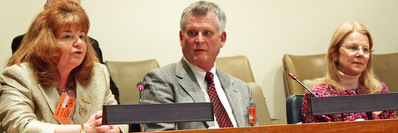
Inspired by the 2008 Conference, “Teaching and Learning in an Interdependent World,” the four teachers who were present shared its content and materials with their colleagues. A team of twelve teachers and the school counselor then came together to devise an integrated curriculum that would teach students the importance of recognizing the interdependency of all nations and peoples of the world. The history of the United Nations—along with a field trip to the UN— together with the concept of world community, the appreciation of world cultures and languages and the conservation of resources are part of this curriculum.
After their trip to the UN and their interdisciplinary work in the subject areas, the seventh grade students also identified related needs that exist in the Princeton area and participated in outreach projects. Through their course work and community outreach, students were helped to see that not only is learning connected but the life-paths of all peoples have connections too.
Dr. Linda Dix
Director of Religious Education for Our Lady of Good Counsel School and Parish in Moorestown, New Jersey, received an award for implementing school and parish activities in “twinning” with other schools, both in the U.S. and other countries. The focus of this award presentation was on the work done with St. Francis Primary School in Kingston, Jamaica. Over the years there has been much sharing of books and literature between the children of Our Lady of Good Counsel School and St. Francis School in Jamaica. Parish, community and professional organizations have collected and shipped books and school supplies. Among projects stimulated through “twinning” have been visits from medical and dental personnel from the area to clinics in Kingston. The local chapter of The Delta Kappa Gamma Society International has provided funds for college tuition for a Jamaican teacher. Through the Pemberton (NJ) Rotary Club in collaboration with the Kingston (Jamaica) Rotary Club a project called the Wheelchair Foundation has raised money to provide over 75 wheelchairs for disabled persons, particularly children, in Jamaica.
Click here to view picture slideshow !
Info Fair Exhibitors
An Information Fair that displayed educational resources related to the theme of the Conference was held throughout the lunch break. Materials available included books, leaflets, and posters. Among the Info Fair participants were staff members of the organizations represented by Conference speakers. Brief descriptions of the participating organizations, along with their web sites, follow.
Advocates for Human Rights — Emily Farell, Education Program Associate (www.discoverhumanrights.org).
The Discover Human Rights Institute, offers teachers’ guides on conflict resolution, the restoration of justice after war, the battered woman’s experience, and lesson plans and tool kits on the right to education, housing, and food.
American University Center for Human Rights and Humanitarian Law— Amelia Parker, Program Coordinator (www.wcl.american.edu).
Their Genocide Teaching Project provides resources for high schools on the history and legal concept of genocide, downloadable lesson plans on the violence in Rwanda and Darfur, and a 2008 film series.
Amnesty International USA — James Wood, Asst. to the Deputy Director (www.aiusa.org).
A Nobel Peace Prize winner, AI advocates for the release of prisoners of conscience worldwide through letter writing campaigns, an urgent action network and film.
The Center for Public Integrity — Steven Carpinelli, Media Relations Manager (www.publicintegrity.org).
Produces original investigative journalism to make institutional power more transparent and accountable; reports on, e.g., toxic deception, money interests behind presidential candidates, the black market on animals, and the business of war.
Central Asia Institute — Greg Mortenson, Founder and Executive Director(www.ikat.org).
Dedicated to promoting education, especially for girls, in remote, volatile areas, CAI has built close to 70 schools in Pakistan and Afghanistan without US government financial support; a middle school version of their award-winning bookThree Cups of Tea is now available, as well as a picture book version, Listen to the Wind.
Pennies for Peace — Christiane Leitinger, Director (www.penniesforpeace.org).
Educates American children on global issues and how they can make a positive impact, one penny at a time.
Challenge Farm. Cheryl Thompson, Director (www.challenge-kenya.org).
Provides a home, hot meals, medical care, life skills and education in literacy and mathematics to 102 former street children in Kitale, in the Rift Valley of Western Kenya. They also work with impoverished women and babies in nearby Kipsongo.
Children’s Defense Fund — Marion Wright Edelman, President (www.childrensdefense.org).
Works to improve the quality of life for America’s children on issues such as health insurance coverage, increasing adoptions, etc. Edelman’s book,The Sea Is So Wide and My Boat Is So Small, reflects on progress and setbacks in the last 40 years.
Concern Worldwide — Delia Dunlap, Global Education Program Coordinator (www.concern.net).
Works with the poor in 28 countries in education, emergency response and preparedness, health, and livelihoods. As part of their education initiative, they go into NYC classrooms, offering free curriculum materials and support to K-12 teachers on global issues.
Facing History and Ourselves — Peter Nelson, Director, NY region(www.facinghistory.org).
Works with educators to connect history to moral choices in today’s world, in areas such as anti-Semitism, bullying and ostracism, conformity and obedience, homophobia, eugenics, reconciliation and repatriation, terrorism and more.
Global Education Motivators (GEM) — Wayne Jacoby, President (www.gem-ngo.org).
Bringing the world into the classroom, GEM works with educators K-16 through onsite and distant learning workshops, using advanced communications technology. They offer videoconferencing packages with resource materials on topics such as The Lost Boys of Sudanand The UN in Your World, and will customize programs on a wide variety of global issues.
Global Kids — Molly Delano, Director of Programs (www.globalkids.org).
Through leadership programs, digital literacy, a high school for global citizenship in Brooklyn, partnerships in NYC and professional development, they enable and inspire urban youth to go on to higher education and become global and community leaders.
Habitat for Humanity NYC — Ann Kone, Director of Development and Communications (www.habitatnyc.org).
An independent affiliate of Habitat for Humanity Int’l, they work with professional contractors, family partner homeowners and volunteers to build about 25 houses a year for the working poor in the 5 boroughs of NY City.
Heifer InternationalPatricia Stanley Keay, Community Relations Coordinator-CT, NY, NJ
(www.heifer.org).
Committed to ending hunger and poverty worldwide and caring for the earth; since 1944 they have helped 92 million families in 125 countries through gifts of livestock and training in environmentally sound agriculture.
Human Rights First Elisa Massimino, CEO and Exec. Director
(www.humanrightsfirst.org).
Works at the highest levels of policy-making and the courts to promote the rule of law and protect people at risk—refugees, victims of crimes against humanity, advocates targeted for defending the human rights of others, etc.
Human Rights Watch (www.hrw.org).
Investigates and exposes human rights abuses and holds abusers accountable. Their Children’s Rights Division issues press releases on actions (e.g., banning executions of juvenile offenders) and runs an Int’l Film Festival High School Program (Jennifer Nedbalsky, Program Director).
Office of the High Commissioner for Human Rights (UNOHCHR) –Craig Mokhiber, Deputy Director (www.ohchr.org).
Publishes the Universal Declaration of Human Rights and brochures on the rights of the child, refugees, and core UN Human Rights treaties; for children, primary and secondary, there is ABC: Teaching Human Rights.
Save the Children Alliance — Gorel Bogarde, UN Representative (www.savethechildren.net).
An international alliance of 27 national organizations, working in more than 110 countries, to ensure the well-being of children; has programs in education, emergencies, health, HIV/AIDS, malnutrition, and saving newborns. In conjunction with Save the Children USA, (www.savethechildren.org) publishes a large and colorful packet for elementary students on preventing violence against children called Safe You and Safe Me, which can be downloaded from the US website.
Sesame Workshop — Jodi Lefkowitz, Mgr., Corporate Communications
(www.Seasameworkshop.org). A non-profit organization that creates educational content for children, delivered through TV, radio, books, magazines, computers, film, video and community outreach. Their Muppet Diplomacy adapts Sesame Street to places as diverse as the Middle East, South Africa, China, Russia, Bangladesh and Latin America.United Nations Dept. of Public Information (DPI) — Kiyotaka Akasaka, Under-Secretary-General for Communications and Public Information (www.un.org).
The communications arm of the United Nations, providing UN documents, press releases and a video lending library of UN films. Educational Outreach –Yvonne Acosta, Chief, includes: A Global Model UN;
Cyberschoolbus–Bill Yotive, Chief (www.un.org/cyberschoolbus)
an online resource disseminating information on international issues and the UN through teaching materials and activities for primary, intermediate and secondary levels; and for teacher training, UN Chronicle (www.un.org/chronicle) the magazine of the UN, with articles on the UN agenda, economic and social development, the arts in a global context, etc.
USA for UNHCR — Lilli Tnaib, Public Information Asst. (www.usaforunhcr.org).
The American branch of the UN Refugee Agency United Nations High Commissioner for Refugees, Gonzalo Vargas Llosa, Sr. Policy Advisor (
www.unhcr.org). Leads and coordinates action for the worldwide protection of refugees, people whose nationality is disputed, and internally displaced persons. Educational materials are free and can be ordered from the public information office (usawa@unhcr.ch).
They include a Human Rights Teaching Kit, a Teachers’ Newsletter with information about World Refugee Day activities, Refugee Teenagers Magazine, and a video collection.US Fund for UNICEF Kate Weber, Deputy Director, NGOs(www.unicefusa.org).
Works in 161 countries and territories in disease prevention, safe childbirth, nutrition, sanitation and education; provides emergency response to global crises; sends “School in a Box” to disaster areas; lesson plans for grades 6-12 are at www.teachunicef.org .
The World Federation for Mental Health — Deborah Maguire, Director (www.wfmh.com).
Promotes mental health awareness, prevention of mental disorders, and access to appropriate care worldwide; in 2007 established theCenter for Transcultural Mental Health to broaden understanding of how intercultural issues impact diagnosis and treatment; in Africa, addressed the mental health consequences of HIV/AIDS. Information packets are on their website.
Women for Afghan Women — Shakila Hamidi, Program Officer(www.waw.org).
Advocates for the full inclusion of women into Afghan life and public awareness of the situation in Afghanistan; provides cultural events showcasing Afghan women scholars, activists and artists, English classes for Afghan women, classes to introduce Afghan-American children to their culture, and domestic counseling. They are affiliated with the
Initiative to Educate Afghan Women, a program bringing Afghan women to the US for undergraduate degrees.
